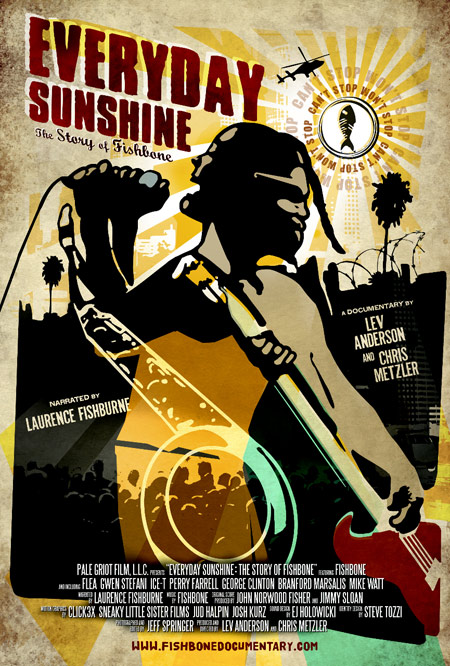
The Story of Fishbone
Pale Griot
As far as film fodder goes, you probably can’t go wrong with choosing a rock band as the subject for a documentary. The egos, the inherent struggle to “make it,” the potential for alcohol and drug abuse, the lurid tales of debauchery—just about any band is going to have a story of some sort. And Fishbone, the LA coterie that managed to fuse ska, punk, funk, heavy metal and just about everything in between, is no different. Hence, Everyday Sunshine.
Tracing the band’s formation during their teenage years, when being bussed to the white suburbs from South Central LA helped expand their musical influences, the film shows what a true anomaly Fishbone was and is. The music industry at large was as segregated as the band’s hometown, and the all-black six-piece group didn’t fit in with the R&B and pop dominating black radio, while also sticking out amongst the punk crowd, not only for the color of their skin, but for not following the typical hardcore blueprint. Being conspicuous ended up not being such a bad thing, though, and with their manic live show turning any head bearing witness to it, they were signed to Columbia Records before the ink was dry on their high school diplomas.
With the documentary switching back and forth between the Fishbone chronology and current interviews with the band’s founding members, of which only singer Angelo Moore and bassist John Norwood Fisher remain in the fold, one knows that the story doesn’t necessarily turn out as well as one might hope for the band. After reaching a critical and commercial peak with 1991’s The Reality of My Surroundings, things took an unexpected turn upon the release of the follow-up, 1993’s Give a Monkey a Brain and He’ll Swear He’s the Center of the Universe. Guitarist Kendall Jones left the band to join a cult headed up by his father. Things for Fishbone subsequently began to unravel, with Columbia releasing them from their contract and keyboardist Chris Dowd quitting. In the subsequent years, drummer Fish Fisher and trumpet player Walt Kibby also left the band, while the group’s lagging record sales had them jumping from one label to the next.
With countless notable names ranging from Ice-T to members of No Doubt, Jane’s Addiction and the Red Hot Chili Peppers captured on film singing the band’s praises, Everyday Sunshine reveals what the majority of the band’s records failed to capture: their lasting legacy. As such, it is disheartening, if not surprising, that Fishbone has sunk to playing half-empty clubs and releasing records to little response. Moore even had to move in with his mother after being evicted for not paying his rent. Still, Norwood and Angelo seem convinced that a return to glory still awaits them, even if they don’t know how to attain it (or how to even really talk to each other). At one point, Moore admits that getting the original line-up back together would be the easiest thing to do, but even if it was possible, he seems hesitant to go the reunion route.
Amazingly enough, Jones shows up unexpectedly at a show in Berkeley, the first time his former bandmates had seen him in 15 years. With Chris Dowd also making a re-appearance, we are ultimately left with the belief that a proper reunion is sure to be, and with it, Fishbone’s fortunes are due to change. (The former has yet to take place.) This happy ending rings a little hollow, as more importantly, the creative spark that once fueled Fishbone appears to be extinguished. What perhaps both the band and the film fail to realize is that not every band is built to last or for financial security, and that’s okay, even if it’s not an ideal storyline. Neverthess, Everyday Sunshine successfully captures a band that at its best had no shortage of ingenuity and vision.
The Rock of Art
The Book of Drugs
The Gories Live Review
Jeff Mangum and Califone Live Reviews
Scud Mountain Boys Live Review
Kill All Redneck Pricks: A Documentary Film About a Band Called Karp
Death of Samantha Live Review
Kathryn Calder and Mark Eitzel Live Review
The Ballad of Mott the Hoople
I Want My MTV: The Uncensored Story of the Music Video Revolution
Lindsey Buckingham Live Review
Scratch Acid Live Review
Def Jam Recordings: The First 25 Years of the Last Great Record Label
Beats, Rhymes & Life: The Travels of A Tribe Called Quest
